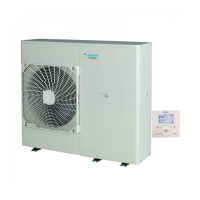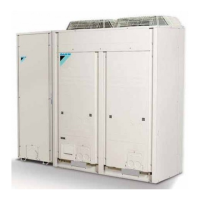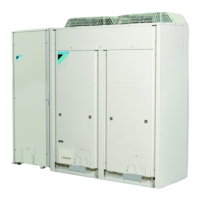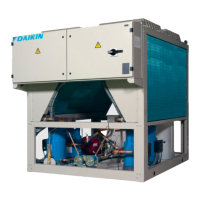Operation manual
9
EWAQ+EWYQ009~011ACV3 + EWAQ+EWYQ009~013ACW1
Packaged air-cooled water chillers and packaged reversible air to
water heatpumps
4PW51588-1
OPERATING THE REMOTE ALARM OPTION
The optional EKRP1HB remote alarm address card can be used to
remotely monitor your system. This address card offers 2 voltage free
outputs.
■ Output 1 = alarm output: this output will be enabled when your
unit is in error condition in case of default setting of field setting
parameter [C-01]. Refer to "[C] Alarm output logic of EKRP1HB"
on page 10 for other possibilities.
■ Output 2 = ON/OFF output: this output will be enabled when
your unit is in ON condition.
For more details about the wiring connections of this option, refer to
the wiring diagram of the unit.
FIELD SETTINGS
The unit should be configured by the installer to match the installation
environment (outdoor climate, installed options, etc.) and user
demand. Thereto, a number of so called field settings are available.
These field settings are accessible and programmable through the
user interface.
Each field setting is assigned a 3-digit number or code, for example
[5-03], which is indicated on the user interface display. The first digit
[5] indicates the 'first code' or field setting group. The second and
third digit [03] together indicate the 'second code'.
A list of all field settings and default values is given under "Field
settings table" on page 12. In this same list, we provided for 2
columns to register the date and value of altered field settings at
variance with the default value.
A detailed description of each field setting is given under "Detailed
description" on page 9.
Procedure
To change one or more field settings, proceed as follows.
1 Press the z button for a minimum of 5 seconds to enter FIELD
SET MODE.
The $ icon (3) will be displayed. The current selected field
setting code is indicated ; (2), with the set value displayed to
the right - (1).
2 Press the bgi button to select the appropriate field
setting first code.
3 Press the bgj button to select the appropriate field
setting second code.
4 Press the pfi button and pfj button to change
the set value of the select field setting.
5 Save the new value by pressing the pr button.
6 Repeat step 2 through 4 to change other field settings as
required.
7 When finished, press the z button to exit FIELD SET MODE
.
Detailed description
[0] User permission level
If required, certain user interface buttons can be made unavailable for
the user.
Three permission levels are defined (see the table below). Switching
between level 1 and level 2/3 is done by simultaneously pressing
buttons pfi and pfj immediately followed by
simultaneously pressing buttons s and ba, and keeping all 4
buttons pressed for at least 5 seconds (in normal mode). Note that no
indication on the user interface is given. When level 2/3 is selected,
the actual permission level — either level 2 or level 3 — is
determined by the field setting [0-00].
2
3
1
NOTE
Changes made to a specific field setting are only
stored when the pr button is pressed. Navigating to a
new field setting code or pressing the z button will
discard the change made.
NOTE
■ Before shipping, the set values have been set as
shown under "Field settings table" on page 12.
■ When exiting FIELD SET MODE, "88" may be
displayed on the user interface LCD while the unit
initialises itself.
Button
Permission level
1 2 3
On/off button
o
operable operable operable
Operation changeover
button
h/c
operable operable operable
Sanitary water heating
button
w
– Not available –
Sanitary temperature
adjust buttons
wbi
wbj
– Not available –
Temperature adjust
buttons
bgi
bgj
operable operable operable
Time adjust buttons
pf
i
pf
j
operable
Programming button
<
operable
Schedule timer enable/
disable button
pr
operable operable
Quiet mode button
s
operable
Weather dependent
set point button
ba
operable
Inspection/test
operation button
z
operable
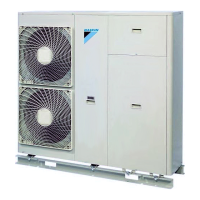
